[English] 日本語
 Yorodumi
Yorodumi- PDB-4j6s: 14-3-3gamma complexed with the N-terminal sequence of tyrosine hy... -
+ Open data
Open data
- Basic information
Basic information
| Entry | Database: PDB / ID: 4j6s | ||||||
|---|---|---|---|---|---|---|---|
| Title | 14-3-3gamma complexed with the N-terminal sequence of tyrosine hydroxylase (residues 1-43) | ||||||
 Components Components |
| ||||||
 Keywords Keywords | HYDROLASE / 14-3-3 proteins / peptide binding / Dopamine synthesis / signal transduction / regulatory proteins / tyrosine hydroxylase / phosphorylation | ||||||
| Function / homology |  Function and homology information Function and homology informationtyrosine 3-monooxygenase / tyrosine 3-monooxygenase activity / dopamine biosynthetic process from tyrosine / embryonic camera-type eye morphogenesis / epinephrine biosynthetic process / Catecholamine biosynthesis / norepinephrine biosynthetic process / hyaloid vascular plexus regression / positive regulation of cell-cell adhesion / eye photoreceptor cell development ...tyrosine 3-monooxygenase / tyrosine 3-monooxygenase activity / dopamine biosynthetic process from tyrosine / embryonic camera-type eye morphogenesis / epinephrine biosynthetic process / Catecholamine biosynthesis / norepinephrine biosynthetic process / hyaloid vascular plexus regression / positive regulation of cell-cell adhesion / eye photoreceptor cell development / phosphorylation-dependent protein binding / melanosome membrane / positive regulation of T cell mediated immune response to tumor cell / synaptic transmission, dopaminergic / mating behavior / regulation of neuron differentiation / eating behavior / dopamine biosynthetic process / pigmentation / protein kinase C inhibitor activity / regulation of heart contraction / smooth endoplasmic reticulum / Regulation of localization of FOXO transcription factors / anatomical structure morphogenesis / Activation of BAD and translocation to mitochondria / regulation of signal transduction / protein targeting / Chk1/Chk2(Cds1) mediated inactivation of Cyclin B:Cdk1 complex / SARS-CoV-2 targets host intracellular signalling and regulatory pathways / heart morphogenesis / negative regulation of protein kinase activity / cellular response to glucose starvation / SARS-CoV-1 targets host intracellular signalling and regulatory pathways / RHO GTPases activate PKNs / insulin-like growth factor receptor binding / negative regulation of TORC1 signaling / visual perception / Loss of Nlp from mitotic centrosomes / Loss of proteins required for interphase microtubule organization from the centrosome / Transcriptional and post-translational regulation of MITF-M expression and activity / Recruitment of mitotic centrosome proteins and complexes / Recruitment of NuMA to mitotic centrosomes / Anchoring of the basal body to the plasma membrane / protein sequestering activity / protein kinase C binding / AURKA Activation by TPX2 / animal organ morphogenesis / learning / TP53 Regulates Metabolic Genes / Translocation of SLC2A4 (GLUT4) to the plasma membrane / locomotory behavior / receptor tyrosine kinase binding / regulation of synaptic plasticity / positive regulation of T cell activation / memory / cytoplasmic side of plasma membrane / cellular response to insulin stimulus / synaptic vesicle / Regulation of PLK1 Activity at G2/M Transition / intracellular protein localization / presynapse / regulation of protein localization / heart development / cytoplasmic vesicle / response to ethanol / perikaryon / response to hypoxia / neuron projection / mitochondrial matrix / iron ion binding / protein domain specific binding / axon / focal adhesion / perinuclear region of cytoplasm / enzyme binding / signal transduction / RNA binding / extracellular exosome / identical protein binding / nucleus / membrane / cytoplasm / cytosol Similarity search - Function | ||||||
| Biological species |  Homo sapiens (human) Homo sapiens (human) | ||||||
| Method |  X-RAY DIFFRACTION / X-RAY DIFFRACTION /  SYNCHROTRON / SYNCHROTRON /  MOLECULAR REPLACEMENT / Resolution: 3.08 Å MOLECULAR REPLACEMENT / Resolution: 3.08 Å | ||||||
 Authors Authors | Mileni, M. / Martinez, A. / Stevens, R.C. | ||||||
 Citation Citation |  Journal: J.Mol.Biol. / Year: 2014 Journal: J.Mol.Biol. / Year: 2014Title: The N-terminal sequence of tyrosine hydroxylase is a conformationally versatile motif that binds 14-3-3 proteins and membranes. Authors: Skjevik, A.A. / Mileni, M. / Baumann, A. / Halskau, O. / Teigen, K. / Stevens, R.C. / Martinez, A. | ||||||
| History |
|
- Structure visualization
Structure visualization
| Structure viewer | Molecule:  Molmil Molmil Jmol/JSmol Jmol/JSmol |
|---|
- Downloads & links
Downloads & links
- Download
Download
| PDBx/mmCIF format |  4j6s.cif.gz 4j6s.cif.gz | 204.2 KB | Display |  PDBx/mmCIF format PDBx/mmCIF format |
|---|---|---|---|---|
| PDB format |  pdb4j6s.ent.gz pdb4j6s.ent.gz | 164.2 KB | Display |  PDB format PDB format |
| PDBx/mmJSON format |  4j6s.json.gz 4j6s.json.gz | Tree view |  PDBx/mmJSON format PDBx/mmJSON format | |
| Others |  Other downloads Other downloads |
-Validation report
| Summary document |  4j6s_validation.pdf.gz 4j6s_validation.pdf.gz | 482.9 KB | Display |  wwPDB validaton report wwPDB validaton report |
|---|---|---|---|---|
| Full document |  4j6s_full_validation.pdf.gz 4j6s_full_validation.pdf.gz | 490.9 KB | Display | |
| Data in XML |  4j6s_validation.xml.gz 4j6s_validation.xml.gz | 33.1 KB | Display | |
| Data in CIF |  4j6s_validation.cif.gz 4j6s_validation.cif.gz | 45.3 KB | Display | |
| Arichive directory |  https://data.pdbj.org/pub/pdb/validation_reports/j6/4j6s https://data.pdbj.org/pub/pdb/validation_reports/j6/4j6s ftp://data.pdbj.org/pub/pdb/validation_reports/j6/4j6s ftp://data.pdbj.org/pub/pdb/validation_reports/j6/4j6s | HTTPS FTP |
-Related structure data
| Related structure data |  1a4oS S: Starting model for refinement |
|---|---|
| Similar structure data |
- Links
Links
- Assembly
Assembly
| Deposited unit | 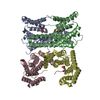
| ||||||||||||||||||||
|---|---|---|---|---|---|---|---|---|---|---|---|---|---|---|---|---|---|---|---|---|---|
| 1 | 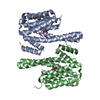
| ||||||||||||||||||||
| 2 | 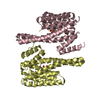
| ||||||||||||||||||||
| Unit cell |
| ||||||||||||||||||||
| Noncrystallographic symmetry (NCS) | NCS oper:
|
- Components
Components
| #1: Protein | Mass: 29165.545 Da / Num. of mol.: 4 Source method: isolated from a genetically manipulated source Source: (gene. exp.)  Homo sapiens (human) / Gene: YWHAG / Production host: Homo sapiens (human) / Gene: YWHAG / Production host:  #2: Protein/peptide | Mass: 4859.459 Da / Num. of mol.: 4 / Source method: obtained synthetically / Source: (synth.)  Homo sapiens (human) / References: UniProt: P07101*PLUS, tyrosine 3-monooxygenase Homo sapiens (human) / References: UniProt: P07101*PLUS, tyrosine 3-monooxygenaseHas protein modification | Y | Sequence details | THE CRYSTALLIZED SEQUENCE CORRESPONDING TO TYROSINE 3-MONOOXYGENASE REPRESENTS THE SPLICING-ISOFORM ...THE CRYSTALLIZ | |
|---|
-Experimental details
-Experiment
| Experiment | Method:  X-RAY DIFFRACTION / Number of used crystals: 1 X-RAY DIFFRACTION / Number of used crystals: 1 |
|---|
- Sample preparation
Sample preparation
| Crystal | Density Matthews: 2.44 Å3/Da / Density % sol: 49.53 % |
|---|---|
| Crystal grow | Temperature: 283 K / Method: vapor diffusion / pH: 7.1 Details: 30% PEG 2000 MME, 0.1M Potassium Thiocyanate, pH 7.1, VAPOR DIFFUSION, temperature 283.0K |
-Data collection
| Diffraction | Mean temperature: 100 K |
|---|---|
| Diffraction source | Source:  SYNCHROTRON / Site: SYNCHROTRON / Site:  APS APS  / Beamline: 23-ID-D / Wavelength: 1.0331 Å / Beamline: 23-ID-D / Wavelength: 1.0331 Å |
| Detector | Type: MARMOSAIC 300 mm CCD / Detector: CCD / Date: Oct 15, 2008 |
| Radiation | Monochromator: Si(111) / Protocol: SINGLE WAVELENGTH / Monochromatic (M) / Laue (L): M / Scattering type: x-ray |
| Radiation wavelength | Wavelength: 1.0331 Å / Relative weight: 1 |
| Reflection | Resolution: 3.08→30 Å / Num. all: 22015 / Num. obs: 111792 / % possible obs: 87.1 % / Observed criterion σ(F): 2 / Observed criterion σ(I): 2 / Redundancy: 5.1 % / Rmerge(I) obs: 0.111 / Net I/σ(I): 11.6 |
| Reflection shell | Resolution: 3.08→3.16 Å / Redundancy: 5.1 % / Rmerge(I) obs: 0.492 / Mean I/σ(I) obs: 3.29 / Num. unique all: 1656 / % possible all: 90 |
- Processing
Processing
| Software |
| ||||||||||||||||||||||||||||||||||||||||||||||||||||||||||||||||||||||||||||||||||||||||||||||||||||||||||||||||||||||||||||||||||||||||||||||||||||||||||||||||||||||||||
|---|---|---|---|---|---|---|---|---|---|---|---|---|---|---|---|---|---|---|---|---|---|---|---|---|---|---|---|---|---|---|---|---|---|---|---|---|---|---|---|---|---|---|---|---|---|---|---|---|---|---|---|---|---|---|---|---|---|---|---|---|---|---|---|---|---|---|---|---|---|---|---|---|---|---|---|---|---|---|---|---|---|---|---|---|---|---|---|---|---|---|---|---|---|---|---|---|---|---|---|---|---|---|---|---|---|---|---|---|---|---|---|---|---|---|---|---|---|---|---|---|---|---|---|---|---|---|---|---|---|---|---|---|---|---|---|---|---|---|---|---|---|---|---|---|---|---|---|---|---|---|---|---|---|---|---|---|---|---|---|---|---|---|---|---|---|---|---|---|---|---|---|
| Refinement | Method to determine structure:  MOLECULAR REPLACEMENT MOLECULAR REPLACEMENTStarting model: PDB ENTRY 1A4O Resolution: 3.08→29.9 Å / Cor.coef. Fo:Fc: 0.93 / Cor.coef. Fo:Fc free: 0.899 / Isotropic thermal model: isotropic / Cross valid method: THROUGHOUT / ESU R Free: 0.514 / Stereochemistry target values: MAXIMUM LIKELIHOOD / Details: HYDROGENS HAVE BEEN ADDED IN THE RIDING POSITIONS
| ||||||||||||||||||||||||||||||||||||||||||||||||||||||||||||||||||||||||||||||||||||||||||||||||||||||||||||||||||||||||||||||||||||||||||||||||||||||||||||||||||||||||||
| Solvent computation | Ion probe radii: 0.8 Å / Shrinkage radii: 0.8 Å / VDW probe radii: 1.2 Å / Solvent model: MASK | ||||||||||||||||||||||||||||||||||||||||||||||||||||||||||||||||||||||||||||||||||||||||||||||||||||||||||||||||||||||||||||||||||||||||||||||||||||||||||||||||||||||||||
| Displacement parameters | Biso mean: 68.709 Å2
| ||||||||||||||||||||||||||||||||||||||||||||||||||||||||||||||||||||||||||||||||||||||||||||||||||||||||||||||||||||||||||||||||||||||||||||||||||||||||||||||||||||||||||
| Refinement step | Cycle: LAST / Resolution: 3.08→29.9 Å
| ||||||||||||||||||||||||||||||||||||||||||||||||||||||||||||||||||||||||||||||||||||||||||||||||||||||||||||||||||||||||||||||||||||||||||||||||||||||||||||||||||||||||||
| Refine LS restraints |
| ||||||||||||||||||||||||||||||||||||||||||||||||||||||||||||||||||||||||||||||||||||||||||||||||||||||||||||||||||||||||||||||||||||||||||||||||||||||||||||||||||||||||||
| LS refinement shell | Resolution: 3.08→3.16 Å / Total num. of bins used: 20
|
 Movie
Movie Controller
Controller



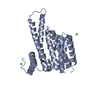

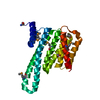





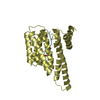
 PDBj
PDBj





